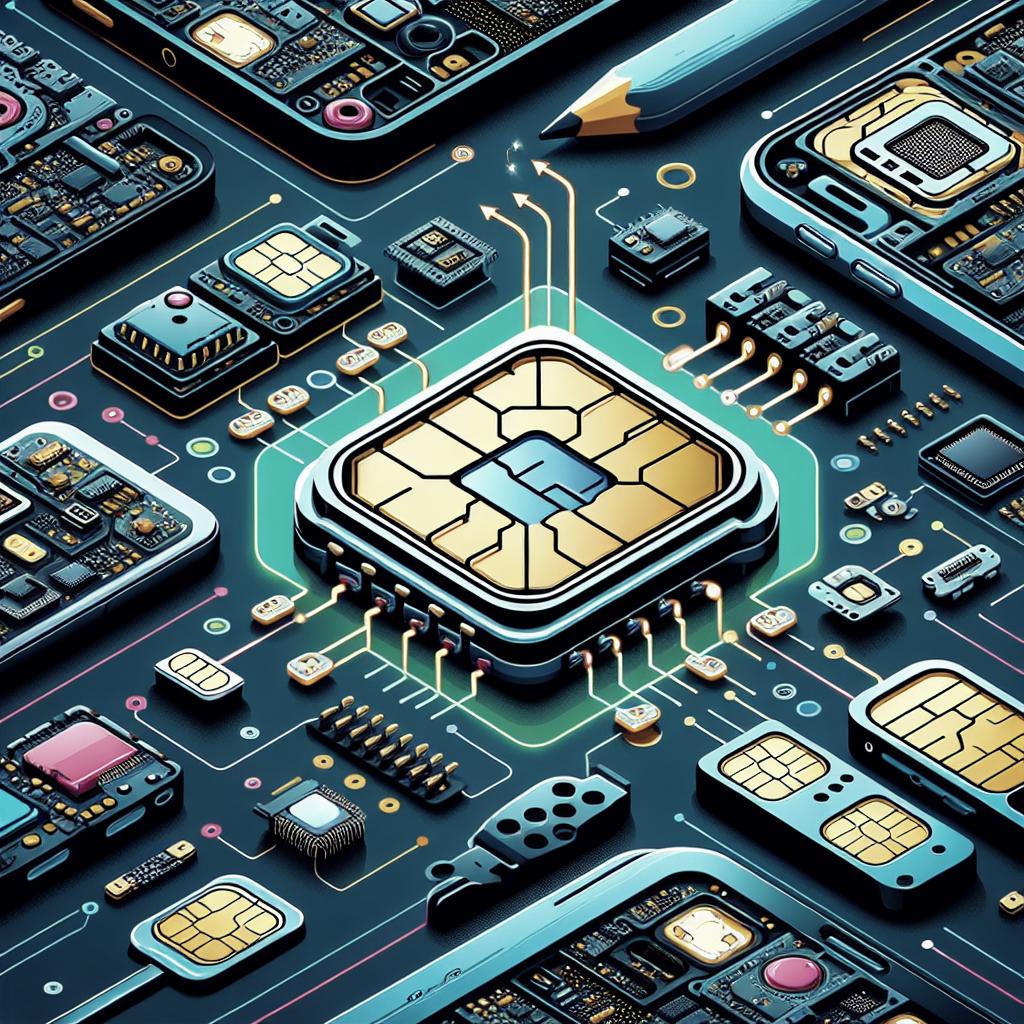The Role of a SIM Card in Mobile Devices
In our digital age, the SIM card stands as an unsung hero of mobile technology, quietly powering our ability to connect globally. Many users have vague ideas about what a SIM card does, but the truth is that it’s essential for identity and connectivity. This article aims to demystify the SIM card, examining its purpose, how it works, the different types available, and both its advantages and drawbacks. We’ll also cast an eye toward the future of SIM technology and answer common questions about its role in mobile devices. Read on to become a SIM card aficionado.
What Is a SIM Card?
A Subscriber Identity Module (SIM) card is a tiny, essential piece of technology found in mobile devices that allows users to connect to their cellular network. In its simplest form, a SIM card is a small chip that fits into your smartphone, where it serves as a pivotal link in connecting your device to a mobile network. It acts as proof of identity for each mobile user, granting the device access to the network, enabling phone calls, text messages, and mobile data usage.
SIM cards store information that is unique to each card and user. This includes the International Mobile Subscriber Identity (IMSI) number and a specific encryption key. These identifiers help secure the communication between the phone and network, providing a layer of security while ensuring that your device is authenticated every time it aims to connect. Such functionality makes the SIM card indispensable in modern telecommunication.
How Do SIM Cards Work?
At its core, a SIM card is your device’s connection to the cellular network. When inserted into a mobile device, the SIM card communicates with the nearest cell tower, transmitting necessary credentials like the IMSI number to authenticate the user on that network. Once authenticated, users can make and receive calls, send and receive texts, and use mobile data services.
Importantly, SIM cards are associated with specific carriers, meaning that the card not only identifies the user but connects them to a particular service provider. This association ties your mobile number to the network, while also determining what services you can access based on your subscription or mobile plan. As technology progresses, more advanced SIM forms have emerged, facilitating seamless connections and enhancing our ability to connect wherever we are.
Types of SIM Cards
Full-Size SIM Card
The full-size SIM card, often referred to as a “1FF” or “1st Form Factor,” was the original version created for mobile devices. It resembles a credit card in size, measuring approximately 85.60 mm x 53.98 mm, making it bulky for today’s compact devices. While no longer used in modern phones, full-size SIM cards played a crucial role during the early days of mobile communication.
This type of SIM card has largely become obsolete with the evolution toward smaller, more efficient designs. However, its contribution to building the initial foundation for other SIM cards remains undeniable, marking the start of a transformative journey in mobile technology.
Mini SIM Card
The mini SIM card, or “2FF,” was a revolutionary step forward in telecommunication, creating a standard that balanced functionality with a more compact design. Introduced in the early 1990s, this SIM card measures approximately 25 mm x 15 mm, earning its place in the annals of technology as the format used during the explosive growth of mobile phone ownership.
Despite its name, the mini SIM was once regarded as a “standard” size and was the most commonly used SIM card for years until the demand for even more compact devices prompted further innovation. Its influence is evident as it helped set the stage for more advanced iterations.
Micro SIM Card
The micro SIM card, or “3FF,” marks another milestone in the downsizing of partnering SIM technology with mobile hardware design. Around half the size of the mini SIM, the micro SIM measures about 15 mm x 12 mm, allowing for slimmer and more refined phone designs. It became particularly popular with the advent of smartphones, offering both portability and user-friendly design.
The micro SIM format facilitated advancements in mobile technology by reducing excess material while maintaining the functionality necessary for optimal network connectivity. This made it a go-to option in smartphone models of the late 2000s and early 2010s.
Nano SIM Card
Introduced in 2012, the nano SIM card, or “4FF,” is the smallest version available currently, measuring approximately 12.3 mm x 8.8 mm. This format eschews nearly all excess plastic, focusing on the essential components to maintain telecom capabilities. Modern smartphones typically use nano SIMs, which help devices to be sleeker and more efficient.
Despite its diminutive size, nano SIM cards are packed with the same capabilities as their predecessors, showcasing how technology can be miniaturized to streamline the user experience without sacrificing performance. The shift to nano SIMs in recent years reflects both user demand for compact technology and the phone industry’s push for design efficiency.
Embedded SIM Card
The arrival of the embedded SIM card, or eSIM, represents the latest evolution in SIM technology. Unlike traditional SIM cards, eSIMs are soldered directly into a device’s circuitry during manufacturing, eliminating the need for a physical card slot. This innovation comes in response to the demand for devices that are both more resilient to environmental factors and offer enhanced security.
eSIMs allow users to switch network carriers without needing to swap physical cards, which simplifies processes such as international roaming and changing providers. This format also supports multiple profiles, offering flexibility for users to manage various phone numbers and networks directly from their devices.
Advantages of SIM Cards
Easier Phone Use While Traveling
One of the most significant advantages of SIM cards is their role in streamlining international travel for phone users. When stepping into another country, simply swapping your home SIM card with a local one can save significant amounts on roaming charges by providing local call rates and data charges. This presents a more economical way of staying connected, relative to high roaming fees.
This capability further extends to the use of dual-SIM devices, which allow travelers to manage both their home and local phone numbers concurrently. This dual function makes managing personal and business communications effortless while abroad.
Quickly Swappable Into New Devices
The convenience of transferring a SIM card between devices is another reason why they are an essential part of mobile communication. Users can swap their SIM card into different handsets and instantly gain access to their existing phone plan. This proves particularly useful when upgrading devices or when a phone unexpectedly stops functioning.
This ease of swapping allows users to retain their network plan, contacts, messages, and other associated data without the hurdles of setting up their phones as new devices. The transferability of SIM cards underscores their role in providing continuity and accessibility in a mobile-driven world.
Disadvantages of SIM Cards
Inflates Phone Bills While Traveling
On the flip side, SIM cards can sometimes induce increased expenses, predominantly through roaming charges. Utilizing a home SIM outside of its designated network can result in high costs for calls, messages, and data usage. Roaming fees have historically been a considerable complaint among travelers.
Such costs can be mitigated by acquiring a local SIM card in the destination country or leveraging international plans. However, these options can become an inconvenience if you’re frequently on the move, emphasizing the need for awareness around roaming fees when planning travel.
Vulnerable to Threats
As with any technology, SIM cards aren’t immune to security threats. Vulnerabilities such as SIM card swapping, where a malicious actor gains unauthorized access to a user’s phone number by manipulating mobile carrier systems, can lead to severe breaches of privacy and data theft.
Additionally, physical loss or theft of the SIM card can potentially compromise personal information stored on the card. As mobile security measures advance, such as with eSIMs or dual-factor authentication, there is hope for increased protection against these threats.
The Future of SIM Cards
The landscape of SIM technology continues to evolve with advances like eSIMs and even iSIMs (Integrated SIMs), which could further transform how mobile devices are used and accessed worldwide. The trend leans towards seamless integration, eliminating the need for physical cards, leading to potential cost reductions in manufacturing and repairs.
This move also invites broader possibilities for connected devices in IoT ecosystems, enabling more gadgets to communicate via cellular networks without significant barriers. As technology develops, we expect SIM cards to continue evolving, providing enhanced connectivity, security, and user convenience.
Frequently Asked Questions
What exactly does a SIM card do?
A SIM card serves three primary functions: it uniquely identifies the mobile user to the network, it stores your phone number, and it manages your phone’s access to network services. This small card is essentially your personal identity in the vast world of cellular networks, allowing you to make calls, send texts, and use data.
Can a phone work without a SIM card?
Technically, a phone can function without a SIM card, but its capabilities will be severely limited. You would still be able to use the device on Wi-Fi for browsing the internet or using apps. However, the phone wouldn’t be able to make cellular calls, send texts, or access mobile data unless equipped with an eSIM or linked to a carrier network.
Lessons Learned
| Aspect | Description |
|---|---|
| Definition | SIM cards are smart modules that store unique subscriber information and enable cellular network access. |
| Operation | They authenticate devices to networks by providing vital user credentials. |
| Variations | From full-size to nano and recent eSIMs, SIM cards have evolved to become smaller and more efficient. |
| Pros | Essential for easy travel communication and device transferability. |
| Cons | Potential for high travel fees and vulnerability to security threats. |
| Future | eSIM technology promotes more integrated, flexible, and secure telecommunications. |


